Indian Wildlife Spectacular Photography Tour Report 2024
3 May 2024























































































Oriental Pratincoles were dotted around the dry lake beds at the Little Rann of Kutch (image by Mike Watson)

Close-up of a Tiger from Neemdela Gate, just another tiger walking on a jeep track (image by Mike Watson)

Gaur bull at Tadoba Andhari Tiger Reserve – absolute unit! (image by Mike Watson)

The dramatic Crimson Rose, a species of swallowtail butterfly at Tadoba Andhari Tiger Reserve (image by Mike Watson)

Small Pratincoles were again numerous on the sandy banks of the Chambal River (image by Mike Watson)

Booted Eagle at Little Rann of Kutch, its ‘landing lights’ are on (image by Mike Watson)

Montagu’s Harrier male at Blackbuck National Park, home to the world’s largest winter harrier roost (image by Mike Watson)

Another genuine Tiger snarl, Jamna Meadows Tadoba Andhari Tiger Reserve (image by Mike Watson)

Don’t look back in anger Choti Tara. She is known for her bad temper and regularly charges jeeps (image by Mike Watson)

Choti Tara (‘Little Star’) has reigned supreme in the core area of Tadoba Andhari Tiger Reserve since we first saw her there in 2018, outliving supermodel Tigress Maya. She is still going strong in 2024 (image by Mike Watson)

Wolf at Blackbuck National Park (image by Mike Watson)

Rosy Starlings gather in their thousands at the Little Rann of Kutch to gorge on Salvadora persica berries, before their northward migration to Central Asia (image by Mike Watson)

Sloth Bears are apparently on the decline in Tadoba Andhari Tiger Reserve in response to a surge in tiger numbers (image by Mike Watson)

A genuinely snarling Chota Makta awakes from his slumber (image by Mike Watson)

Mir lady at Little Rann of Kutch. Many Mir people moved south from Rajasthan during times of drought (image by Mike Watson)

A vixen Desert Fox and her delightful cubs at Little Rann of Kutch – one of the highlights of the tour! (image by Mike Watson)

A terrific close encounter with the bizarre Great Stone-curlew, another declining inhabitant of Northern India’s large, slow-flowing rivers, which can be easily seen at the Chambal River (image by Mike Watson)

Mugger Crocodile on the other hand is much more dangerous! (image by Mike Watson)

Blackbuck National Park has got to be the easiest place in the world to see Wolves, they do not need a thick winter coat in 40 degrees Celsius! (image by Mike Watson)

Crested (or Oriental) Honey Buzzard at Tadoba Andhari Tiger Reserve, the blood red eye indicates it is a male (image by Mike Watson)

Savannah Nightjar, a more normal relaxed pose at Tadoba Andhari Tiger Reserve (image by Mike Watson)

Point-blank daytime views of the intricately camouflaged Sykes’s Nightjar was another highlight of the 2024 tour, lucky as we missed it at the Little Rann of Kutch for the first time (image by Mike Watson)

A Painted Stork by the tranquil Chambal River (image by Mike Watson)

Young Striped Hyaenas raise their shaggy manes to make themselves look more threatening (image by Mike Watson)

Chotka Matka, the biggest and baddest boss of Tadoba Andhari Tiger Reserve (image by Mike Watson)

Choti Tara sets off for a walk along one of Tadoba’s busy jeep tracks, entourage of tourist admirers in tow (image by Mike Watson)

Desert (Red) Fox cubs by their den at the Little Rann of Kutch (image by Mike Watson)

Long-tailed Shrike at Blackbuck National Park. Sadly shrikes seem to be less common in the Indian countryside these days (image by Mike Watson)

Asiatic Wild Asses at the Little Rann of Kutch, as the sun slips into a thick layer of dust (image by Mike Watson)

Asiatic Wild Ass trio at Little Rann of Kutch, one of their last strongholds and the easiest place in the world to see them (image by Mike Watson)

A Mottled Wood Owl blends in perfectly to the tree bark of its nest site at Tadoba Andhari Tiger Reserve (image by Mike Watson)

An endangered Indian Softshell Turtle slides into the Chambal River, almost everything there is at least endangered (image by Mike Watson)

A fine male Blackbuck struts around his harem at Blackbuck National Park (image by Mike Watson)

Bengal (or Indian) Fox, is the other fox species at Little Rann of Kutch, note the black tail and short snout (image by Mike Watson)

A Spotted Owlet peers out of its des res in the little village of Holi Pura, before it was rudely evicted (image by Mike Watson)

A visit to a marble factory at Agra was a real eye-opener, seeing how the centuries-old techniques of inlaying precious stones have not changed a bit! (image by Mike Watson)

Shaking Tiger, Neemdela Gate, Tadoba Andhari Tiger Reserve (image by Mike Watson)

Gaudy Lesser Flamingos at Little Rann of Kutch (image by Mike Watson)

Lothario ‘Y-mark’ takes an afternoon dip in a quiet corner of Tadoba’s Agarzari Zone – FAB-U-LOUS! (image by Mike Watson)

A Wolf chasing Blackbuck at Blackbuck National Park, their favourite prey here (image by Mike Watson)

A truly gorgeous Leopard lit up our early morning at Tadoba, it was sadly a reminder for some not to stop for peacocks during big cat time (image by Mike Watson)

Fake Tiger snarl near Jamni Meadows, Tadoba Andhari Tiger Reserve (image by Mike Watson)

Indian Stone-curlew hides in plain sight at Tadoba Andhari Tiger Reserve (image by Mike Watson)

A Striped Hyaena has found some tasty dead animal part to chew on in the early morning golden light (image by Mike Watson)

Gharials have impressive spiky tails (image by Mike Watson)

Relaxed Tiger, Jamna Meadows Tadoba Andhari Tiger Reserve (image by Mike Watson)

Sykes was probably not quite as proud of his other bird, the rather underwhelming Sykes’s Lark (image by Mike Watson)

Indian Hare, Blackbuck National Park (image by Mike Watson)

A rare close-up view of a male Gharial’s pot or ‘ghara’, which gives it its name (image by Mike Watson)

The critically endangered Gharial has declined by 98% since the 1930s and is now only found in a small number of unpolluted large rivers in Southern Asia. The Chambal is one of its last sanctuaries (image by Mike Watson)

The facial expressions of langur monkeys make them excellent photo subjects (image by Mike Watson)

Asiatic Wild Dogs tearing an unfortunate Spotted Deer apart at Tadoba, owing to the presence of tigers they have to consume their kills as quickly as possible (image by Mike Watson)

Blackbuck with a Striped Hyaena in the background (image by Mike Watson)

Extreme close-up Tiger, Neemdela Gate Tadoba Andhari Tiger Reserve (image by Mike Watson)

Playful Tiger near Jamna Meadows, Tadoba Andhari Tiger Reserve (image by Mike Watson)

Asiatic Wild Ass against a yellow sky at the Little Rann of Kutch as half of the spectrum still makes it through the atmospheric dust (image by Mike Watson)

Indian Skimmer is another endangered inhabitant of the Chambal River, we did not see any skimming this year (image by Mike Watson)

The Tigress by the lake at Teliya, deep in the heart of Tadoba Andhari Tiger Reserve (image by Mike Watson)

A Yellow Bittern retreats back into the shady darkness of a reedbed at Blackbuck Lodge (image by Mike Watson)

Asiatic Wild Dog (or Dhole) at Tadoba Andhari Tiger Reserve (image by Mike Watson)

Clever Choti Tara takes a dip to cool off before setting off on a long walk to one of her favourite waterholes (image by Mike Watson)

The Taj Mahal, the most beautiful building in the world (image by Mike Watson)

Hang on there’s another one, langurs are such fun to watch when there’s not any tiger action going on (image by Mike Watson)

Often heard, seldom-seen Common Hawk Cuckoo (or ‘Brainfever Bird’) at Tadoba Andhari Tiger Reserve (image by Mike Watson)

Snarling Tiger, Jamna Meadows Tadoba Andhari Tiger Reserve (image by Mike Watson)

Gharials lay their eggs in the sandy banks of the Chambal River (image by Mike Watson)

A feisty Mottled Wood Owl in Tadoba Andhari Tiger Reserve (image by Mike Watson)

Are you looking at me? Tiger in Tadoba Andhari Tiger Reserve (image by Mike Watson)

A brave Gaur, complete with Cattle Egret adornment in a stand-off with a Tiger at Tadoba Andhari Tiger Reserve (image by Mike Watson)

The Caracal-like ears of the lovely Jungle Cat at Tadoba Andhari Tiger Reserve (image by Mike Watson)

A female Gharial enters the water at the Chambal River (image by Mike Watson)

The gorgeous Chestnut-bellied Sandgrouse at Little Rann of Kutch (image by Mike Watson)

Fun lady at the Taj Mahal (image by Mike Watson)

Ridiculously close views of Steppe Eagle at Blackbuck National Park was a feature of our 2024 tour, they appeared to be following Wolf kills (image by Mike Watson)

It is easy to picture Jesus on the Cross on this Ghost Tree at Tadoba Andhari Tiger Reserve (image by Mike Watson)

Needle-like Gharial teeth are adapted for catching fish, they are of no danger to humans (image by Mike Watson)

Asiatic Wild Ass on the hoof – we do our best not to make them run but sometimes they gallop by us on their way somewhere (image by Mike Watson)

A Nilgai, or Blue Bull as the males are called deep in the forest at Tadoba Andhari Tiger Reserve. The antelope that looks like it is made from soare parts of other animals (image by Mike Watson)

A camera trap style image of Chota Makta, showing his massive bulk. The heaviest tiger recorded, from UP state was not far off 400kg. Chokta Makta is thought to be around 275+kg (image by Mike Watson)

There may now be less than 500 pairs of the endangered Black-bellied Tern left in the world. The lovely National Chambal Sanctuary is a last refuge for it (image by Mike Watson)

Indian Skimmers and tourists at the Chambal River (image by Mike Watson)

Langur monkeys like to eat tree flowers! (image by Mike Watson)

One of these two Tigers is a maneater, having killed two gatemen at Neemdela within the last month, now which one? (image by Mike Watson)

A goggle-eyed Savannah Nightjar at Tadoba Andhari Tiger Reserve, in a strange reaction to some noisy tourists (image by Mike Watson)

Natural born killers from Neemdela Gate (image by Mike Watson)
The ninth in our series of India Tiger & Wildlife spectacular tours was another success, filled with great wildlife encounters in this unique country. The itinerary retained destinations like the Taj Mahal, Chambal River, The Little Rann of Kutch and Blackbuck National Park, ending with a tiger grand finale at the amazing Tadoba Andhari Tiger Reserve. We began our adventures in incredible India, as usual, with a visit to the incomparable Taj Mahal in Uttar Pradesh, the most beautiful building in the world. The National Chambal Sanctuary, which protects a long stretch of northern India’s last major unpolluted river was superb, as always, with great looks at some of its very special wildlife, including Gharial and Mugger crocodiles, Indian Softshell and Tent Turtles, as well as a terrific range of bird life such as Great Stone-curlew, Black-bellied, River and Little Terns and Indian Skimmer. We paid another visit to the Bateshwar temple complex, again coinciding with the Hindu festival of Holi, although we successfully managed to avoid being covered in paint powder this time. After returning to the hustle and bustle of Delhi, we took a flight to Ahmedabad in the western state of Gujarat, where we visited two of our favourite places, the delightful Desert Coursers lodge in the Little Rann of Kutch and the truly outstanding Blackbuck Lodge, adjacent to the national park of the same name at Velavadar. We enjoyed some encounters with the endangered Asiatic Wild Ass and had what was probably the best photo session of the entire tour at the Little Rann, in the form of a pair of Desert (Red) Foxes with their cubs, at eye level outside their den in golden early morning sunlight, for a couple of hours. Other notable encounters at the Little Rann included Greater and Lesser Flamingos, thousands of Rosy Starlings, as well as a rather camera-shy pair of Indian Crested Porcupines. Blackbuck National Park was very productive again this time with a total of 10 wolf sightings, a couple of which made worthwhile photo opportunities. Blackbuck National Park is also famous as the easiest place in the world to see the fascinating Striped Hyaena and we were lucky again with a total of three sightings from four Jeep safaris. There was much else to see here in the form of ridiculously close Steppe Eagles, point blank daytime roosting Sykes’s Nightjar, his rather underwhelming Lark, Montagu’s Harrier, Yellow Bittern, and of course the animal the park is named after, the impressive Blackbuck antelope. From Gujarat we crossed the Gulf of Cambay making a short stop in Mumbai, before continuing to Nagpur, gateway to India’s Kipling country tiger reserves. Tadoba reinforced its reputation as the number one destination for tigers, with a whopping 30 sightings as well as other A-list Asian mammals including Sloth Bear, Asiatic Wild Dog and Leopard. In fact, Tadoba is a paradise for mammal watching and other impressive sightings included Asiatic Wild Dog (or Dhole) – multiple sightings including a kill, a pair of Honey Badgers, as well as numerous Spotted Deer, Sambar, Barking Deer, Gaur and Wild Boar. The rare Chowsingha (or Four-horned Antelope) also put in a couple of appearances. There were also many interesting bird sightings including Changeable Hawk Eagle and Crested Serpent Eagle, Mottled Wood Owl, Savannah Nightjar, Indian peafowl (including full fan display) Common Hawk Cuckoo, Orange-headed Thrush, as well as numerous waterbirds.

The Taj Mahal, the most beautiful building in the world (image by Mike Watson)
Whether it is the first or 10th time you have seen the stunning Taj Mahal, it never fails to impress. Fortunately, there was again no sign of any scaffolding etc and we were able to enjoy this amazing building in all its glory. It is of course a mausoleum, a monument to the love of Mughal ruler Shah Jahan for his wife Mumtaz Mahal. Unfortunately, he was never able to build the black marble version for himself, as a mirror image of the Taj on the east Bank of the River Yamuna, before he was deposed by his son. He ended his days in the nearby red Fort of Agra, where his window overlooked the Taj Mahal. After the first of many delicious Indian meals, we continued south to the Chambal River. Most of the animals to be found in and along the banks of the Chambal River of India’s Uttar Pradesh state are red listed, owing to threats such as pollution disturbance habitat change and sand mining, so it is always a privilege to spend time in a place that represents a relic of an ancient landscape. Its special animals are still here and flourishing, and on our 2 boat rides we enjoyed some great photo opportunities with the bizarre looking Gharial, the long-snouted, fish-eating crocodile with jaws full of needle-sharp teeth. Both males and females this time, the males with their pot or ‘ghara’ on the end of their snout. The other crocodilian of the Chambal, Mugger was also very much in evidence and afforded some good portrait opportunities, although they do not do much, just eye you up with disdain presumably. Alas, the river dolphin did not behave for us again, typically showing only briefly while it surfaced in one of the deep pools in the middle of the river. Ironically the Chambal River was spared from development for all these years owing to an ancient curse, which declared it unclean and therefore unsuitable for habitation and disposal of the remains from funeral ghats, which enter so many of India’s other large rivers. It was latterly a hideout of lawless bandits in the labyrinth of sandy ravines along its banks. More recently, the cheap land and untapped resource is of the Chambal, in the form of sand- mining have again been coveted, so despite being a protected area its future is not completely assured. The critically endangered Indian skimmer was not as cooperative as usual, we didn’t see any skimming this time, although we did manage some worthwhile images downstream from the new bridge. We had better luck with the impressive Great Stone-curlew, I can’t think of a better place in the world to photograph this peculiar bird, as well as Black-bellied, River and Little Terns, Bar-headed Geese and Ruddy Shelducks, hundreds of delightful Small Pratincoles, gaudy Painted Storks, Red-naped Ibises and a number of other large land birds such as Osprey, the endangered Egyptian Vulture and a daytime roosting Indian Eagle Owl. The banks of the river also produced Golden Jackal, the one-metre-long Indian Softshell Turtle, Indian Tent Turtle, and a host of other waterbirds including River Lapwing of note. On a quiet afternoon we enjoyed a walk around the nearby village of Holi Pura, where many birds live among decaying historic havelis (ancient, decorated merchants’ houses) with trees growing out of the walls etc. Indian Peafowl, Spotted Owlet and Brown Rock Chat were particularly nice here. We ended a very pleasant day with a delicious masala chai sundowner, overlooking the Bateshwar temple complex on the banks of the River Yamuna, one of our favourite spots. The return to Delhi on the Expressway was something of an ordeal, relieved slightly by the best masala chai of the whole tour, the famous Bikanervala special kulhad tea, served in a disposable earthenware cups – FAB-U-LOUS!
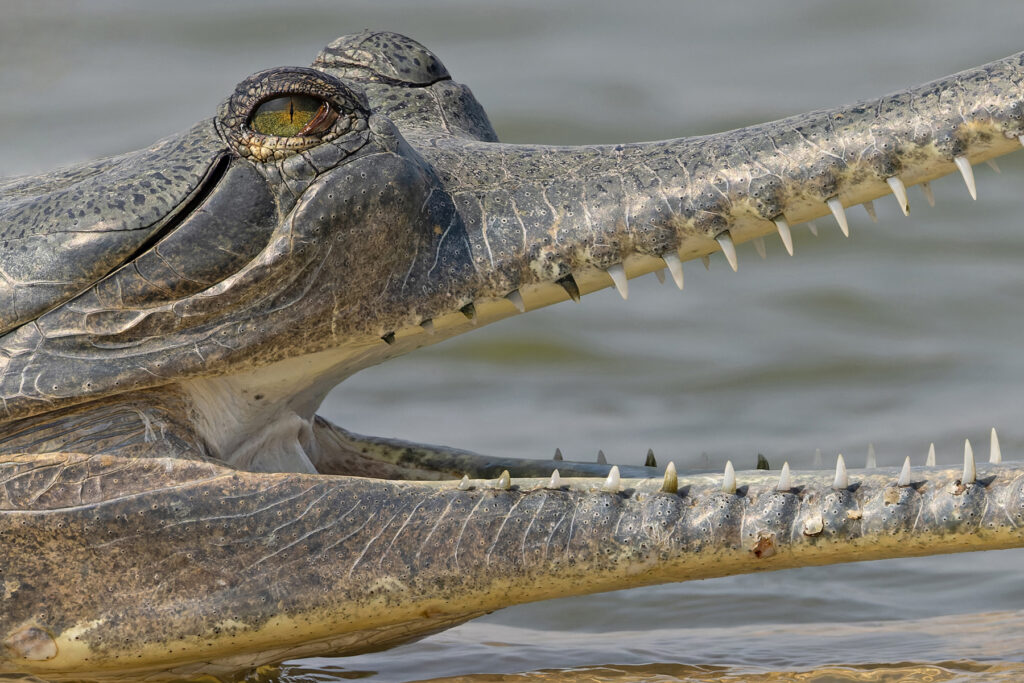
Needle-like Gharial teeth are adapted for catching fish, they are of no danger to humans (image by Mike Watson)
After making our way past brick-laden tractors with their front wheels bouncing off the ground, families of four on motorcycles with no helmet in sight, and at least one million cars in South Delhi, we made it back at a reasonable hour of 7.30pm. An early start the following morning saw us flying west to Ahmedabad in Indian PM Modhi’s home state of Gujarat. Once we had cleared its neat little airport, we were on our way further west to the remote village of Zainabad, our base for the next couple of nights at the famous Desert Coursers Lodge. Our destination here is the Little Rann of Kutch (or ‘Kachchh’) and its Wild Ass Sanctuary, an almost 5,000sq km reserve established in 1972 for the protection of its namesake. Flooded by the monsoon rains it dries out to a vast parched lakebed for the rest of the year, with occasional small island patches of higher ground. As everywhere in India, there is tremendous competition for land use between man and wildlife. For instance salt production is not legal on the Little Rann, yet this area produces around 75% of India’s table salt. It was wonderful to see our genial hosts Dhanraj and his wife Zahida again and they did their best to make our stay a special one. It was now quite hot in Gujarat, touching 40 degrees at midday and things were a little quiet on the vast salt flats of the Little Rann of Kutch. Our first afternoon foray produced 38 Asiatic Wild Asses – the main reason for our visit here, plus a small herd of Nilgai and notably a dog Desert (Red) Fox, near its den – more of him later. There were also a few birds around in the form of a young male Pallid Harrier but unfortunately our usually very exciting and productive night drive drew a blank, the first I’ve experienced here. Maybe owing to the very hot conditions and some habitat degradation on the edge of the Little Rann. Next morning we enjoyed what was probably our best photo session of the entire tour, with a pair of Desert Foxes and their two cubs outside their den out on the salt flats, in gorgeous golden early morning sunlight and at very close range. They seemed completely unconcerned at our presence! Once we had our fill of their very entertaining antics, we headed back for a late breakfast, seeing a pair of Bengal Foxes (the other fox species here, with a dark tail tip), as well as hundreds of noisy Rosy Starlings from Central Asia, gorging themselves on Salvadora persica berries, before their northward migration for the summer. A female Montagu’s Harrier also passed by. The afternoon session was quiet in comparison, with only a close Black-winged Kite on a wire of note and some more sunset Asiatic Wild Asses but they were quite poor compared to the previous evening. We also managed to fail in our attempts to photograph the Indian Crested Porcupines which live in a burrow at Desert Coursers, probably a little over eager approach which had them scuttling back to their den. Our final morning at the Little Rann took us to a nearby wetland where a flock of several hundred flamingos included both gaudy pink Lesser and the much taller Greater. We could manage a few low angle shots as well as flybys before they moved off to a distant shoreline, flushed by a badly timed Marsh Harrier. There appeared to be a colony of Oriental Pratincoles here, as well as some interesting raptors overhead in the forms of Indian Spotted Eagle, Booted Eagle and more Montagu’s Harriers. A Bay-backed Shrike played hard to get but we had more luck with the commoner Ashy-crowned Sparrow-Lark as well as Crested and Greater Short-toed Larks. Chestnut-bellied Sandgrouse also gave itself up on the ground for most, although not photogenic, it was also nice to see the endless murmurations of Rosy Starlings swarming in the distance. The Salvadora bushes were alive with their excited songs, like running water.
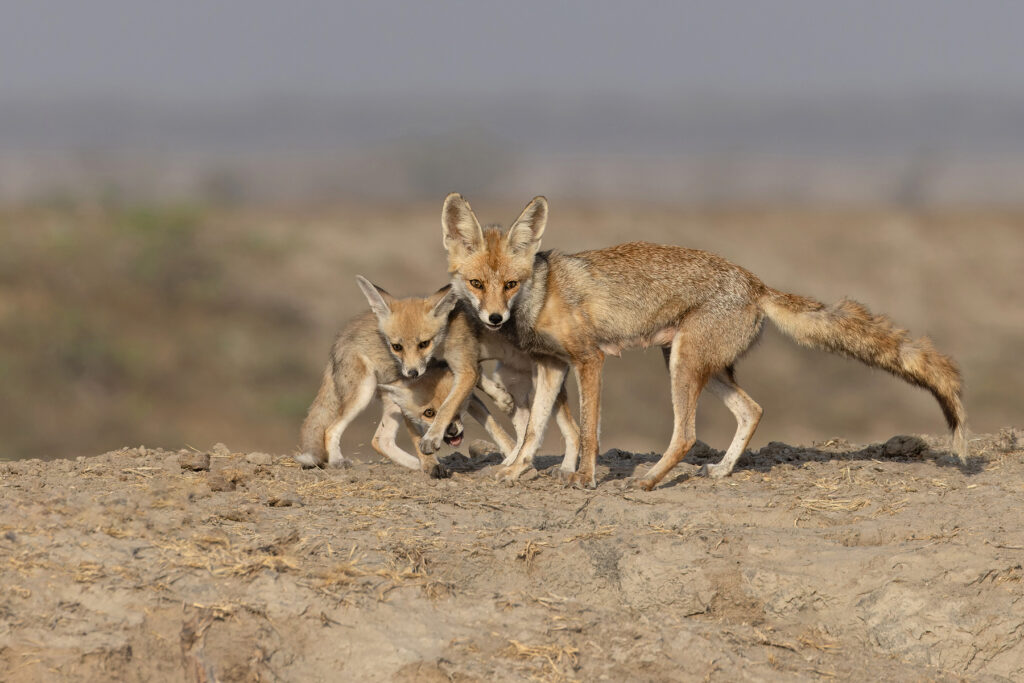
A vixen Desert Fox and her delightful cubs at Little Rann of Kutch – one of the highlights of the tour! (image by Mike Watson)
Our afternoon transfer to Velavadar passed without incident and we settled into our very luxurious new surroundings, plied as ever with endless cups of delicious masala chai. It was hot here as well, out on the shore of the Gulf of Cambay, again almost touching 40 degrees. Activity and acceptable photographic light are compressed into short spells at dawn and dusk, and we did our best to make the most of our time each day. Morning and afternoon jeep safaris both produced wolves, our first afternoon sighting was of one eating a Blackbuck. Its dead victim’s corkscrew horns could be seen poking above the long grass from time to time. Other notable photogenic animals here included a couple of Jungle Cats, two unbelievably tame Steppe Eagles, which appeared to be following the wolf kill, as well as nice opportunities for the likes of Long-tailed shrike, Rufous-tailed Lark and Siberian Stonechat. The distant herds of herbivores, Blackbuck and Nilgai did not offer much photographically today though. Blackbuck Lodge is one of my favourite places in all of the world, nowhere else do I get to enjoy a shower under the stars in my own private courtyard! The food was simply first class and I’m continually impressed by what owner Mickey Desai has created here a true world class destination. The following day was hyaena day, at last. With the absence of an accessible den in the Little Rann of Kutch, I was rather hoping we would score at Blackbuck and today we enjoyed a sighting on both the morning and afternoon jeep safaris, of well-grown pups near the den. There is nowhere else in the world that you can virtually guarantee this strange creature, the youngsters fluffing up their hairy manes to make themselves look bigger! Striped Hyenas are usually strictly nocturnal and as well as being quite uncommon and declining (they are listed as ‘near threatened’ by IUCN), they are consequently difficult to catch up with, despite their very wide distribution from North and East Africa to the Middle East, Caucasus, Central Asia and India. Striped is also the smallest true hyena and lacks the special skull adaptations of its larger Brown and Spotted cousins. Attacks on humans are very rare and it is usually a shy and retiring creature, whose presence is only betrayed by a trail of bones to its den. Other interesting photographic encounters today included a Purple Heron which caught a fish, the same two tame Steppe Eagles again, a point-blank Sykes’s Nightjar at its shady daytime roost, as well as a tremendous territorial display by a male Blackbuck antelope, trotting around his ladies with horns flattened over his back and occasionally chasing off potential interlopers to his harem. What a magnificent sight he made! On our last morning at Blackbuck, we added a couple of water birds to our memory cards, in the form of Marsh Sandpiper and Yellow Bittern. A nice male Montagu’s Harrier made a close flyby on the wetland circuit and among the Rufous-tailed Lark we finally managed to get the local speciality Sykes’s Lark in the frame. A rather distant Jungle Cat was disappointing, but we did get to grips with Indian Grey Mongoose properly today. Three wolves included one pup and we were also able to fill in some gaps in terms of Wild Boar and Nilgai images before it was time to leave for Bhavnagar airport and our onward flight across the gulf to Mumbai. I will be forever grateful to Vijay for getting the so-called 5-star hotel restaurant to open early for us, a truly magnificent feat of persuasion. When it arrived, the food was actually pretty good. I don’t have too much else to say about Mumbai, except it is always nice to leave there.
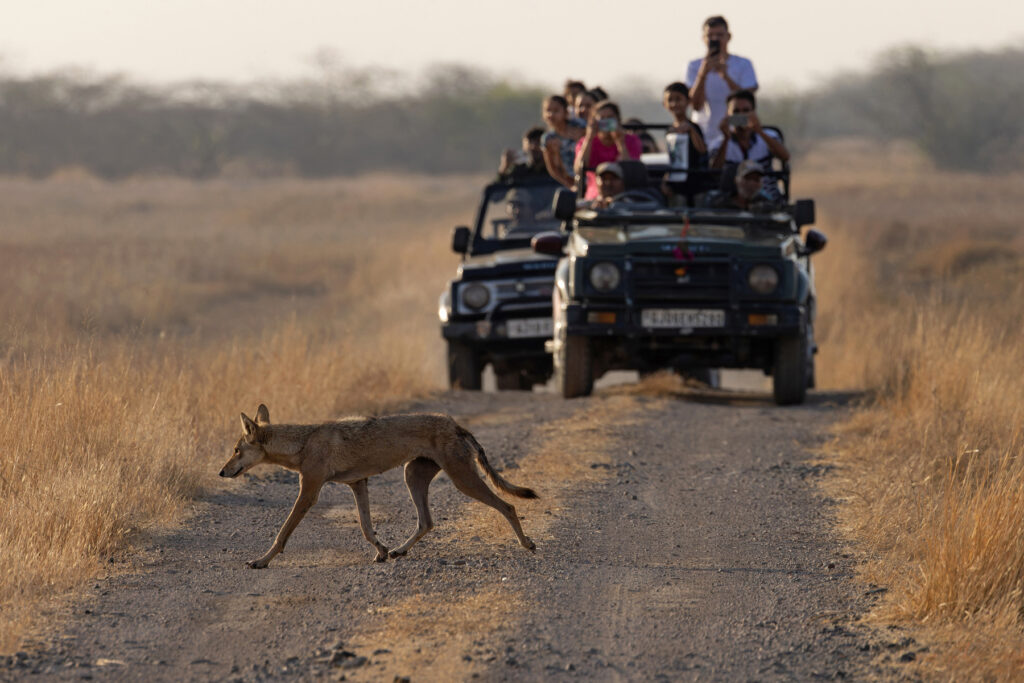
Blackbuck National Park has got to be the easiest place in the world to see Wolves, they do not need a thick winter coat in 40 degrees Celsius! (image by Mike Watson)
We made our way from Nagpur, gateway to Kipling Country, along empty expressways, and eventually endlessly winding country roads through tiny villages to our base for our exploration of the vast Tadoba Andhari Tiger Reserve, hidden away down a quiet dirt track. We were now deep in tiger country, as demonstrated by the news in the afternoon that a tiger had been heard approaching our property, which has an attractive water hole. We waited a while for him, however the sun soon set, and we headed off to eat. We learned later from our hosts that not only did a tiger, but a leopard also visited the water hole within minutes of our departure. We embarked on a daily routine over the following 8 days of a morning jeep safari, followed by brunch and a siesta and then an afternoon safari until sundown.
The huge tiger reserve is accessed by several gates and most of our jeep safaris started from the westerly Khutwanda gate, 5 minutes from our lodge. It was here that we embarked on our first jeep safari, which within minutes produced a Sloth Bear, pacing around a small patch of grassland not far from the track. Unfortunately, it kept its head down most of the time in typical Sloth Bear fashion, not affording anything for the cameras. However, not long after entering the teak/bamboo forest of the core zone of the tiger reserve we did have something to shoot at when we were stunned to come across a magnificent young male Tiger sitting by the track, self-found with only our two jeeps on it! We fired our first volley of tiger shots as it got up and walked a short way, before rolling around on the track. Some great images followed, although some needed a little bamboo stem removal. He eventually made his way into a no-access zone towards Jamni meadows, where we saw him from a distance a little later. We cruised around the core zone enjoying our first sightings of Spotted Deer, Sambar and Barking Deer (Muntjac) but it was not long before we were on the trail of another Tiger, this time down a tight track to a small waterhole, nicknamed ‘Traffic Jam Waterhole’, which we would revisit several times during our stay. Although the tiger was still present, it was not in a particularly photogenic location, facing away from us, but it appeared to have taken interest in something. Unbelievably a pack of Asiatic Wild Dogs had by chance stumbled into its path and predictably the tiger charged them, to the sound of much howling and yelping as the dogs kept in contact after they fled in all directions. Tigers always try to kill wild dogs at every opportunity, being one of their competitors for prey. We bumped into the same group of dogs pausing to cross a jeep track in front of us several kilometres away not long afterwards, they can move at a very rapid pace through the forest. The afternoon jeep ride produced four tigers! However, this was a rather suboptimal sighting of a female and three well-grown cubs on the shore of a reservoir, nevertheless David demonstrated his considerable skills in making something of them with the help of some extra pixels. The safari was otherwise notable for our first sightings of Gaur, the very imposing velvet-coated Indian bison. It is not often that I am impressed by a cow. We finished the Jeep ride with what would be our second, and last (but best) sloth bear sighting of the tour. The large male we had seen in the early morning was ambling along the track ahead of us, before veering away into the bamboo forest. What a terrific start to our exploration of this very special place!
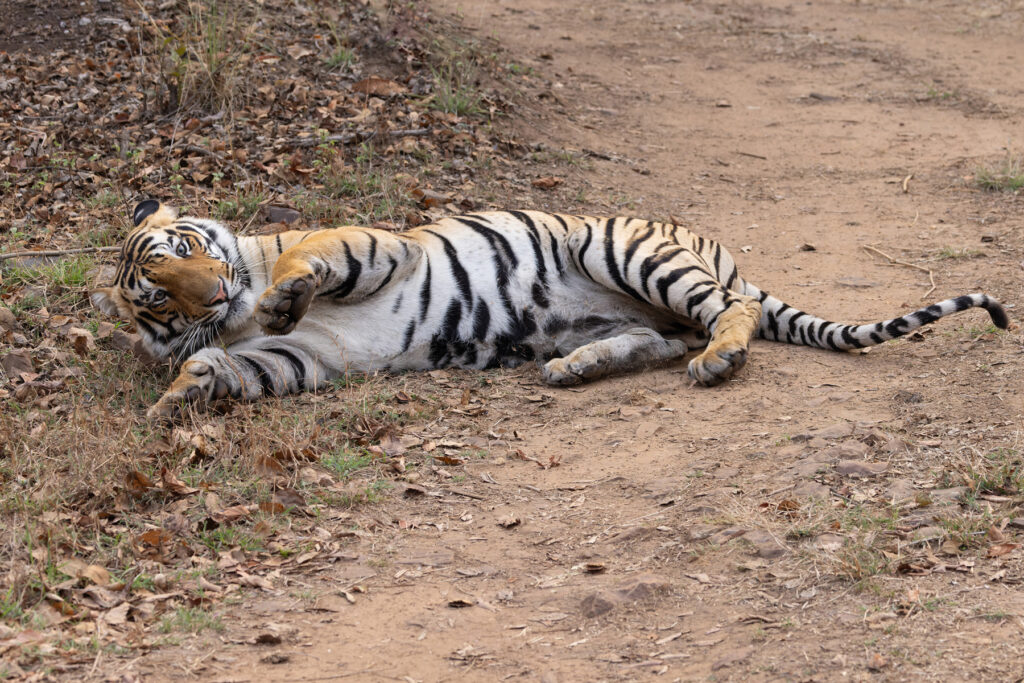
Playful Tiger near Jamna Meadows, Tadoba Andhari Tiger Reserve (image by Mike Watson)
Indian peafowl in full fan display the following morning got this off to a good start and other notable bird sightings included Changeable Hawk Eagle and Mottled Wood Owl. The next tiger duly appeared this morning, the famous Choti Tara ‘Little Star’, she is anything but a little star being a notoriously fierce tigress, well known for charging jeeps and also as the mother of the big bad boss of Tadoba ‘Chota Makta’, who we would see later in the tour. We saw her in 2018 and she is now quite an elderly lady at 12 years old, showing some signs of her age. She walked past our no.#1 Jeep only two metres away but unfortunately no more than a zoo like portrait could be had today. The afternoon marked our first venture away from the Khutwanda gate core area to the Dewada gate and it’s Junona Beat zone. This was a very happy hunting ground for us in 2019 but today it was rather unsatisfactory. We did see another female tiger tigress whose name ‘Collared’ was the cause of some confusion. She does not wear a collar but only has collar-like markings around her neck, so after speaking to our Merati local guide and driver we decided not to bother with her, thinking she was wearing a collar! Of course, we were disappointed when we saw Pauline’s nice photos of her sitting in the grass without a collar! The rest of the Jeep safari was like a rally stage and not at all pleasant, but it did end with a view of a leopard by a kill, just north of the Agarzari gate, unfortunately obscured and not photographable. There were a few birds of interest notably Indian Stone-curlew, a pair with a chick, as well as a few regular waterbirds like Cotton Pygmy Goose, Lesser Whistling Duck and Asian Openbill. The afternoon jeep safari had seen a dramatic build-up of cloud, the sky to the north turning an inky mauve colour and one of our jeeps, which had stayed with the non-collared tiger was heavily rained on, however, the other could enjoy the thunder and lightning show from beyond the edge of the rainstorm. We decided not to use the same drivers and guides for future trips.
A combination of Khutwanda gate and Agarzari gate the following day produced a number of interesting sightings. A Savannah Nightjar roosting by the side of the jeep track at Teliya Lake performed a weird reaction to a jeep full of noisy local tourists that pulled up next to us, rotating its head slowly back and forth with its goggly eyes almost popping out of its head, something I’ve not seen before. Other interesting birds photographed today included Mottled Wood Owl, Jungle Owlet and more Indian Stone-curlews. We had another tiger sighting, this time a male partly obscured and walking across Jamni meadows, but a miss-timed movement by our driver prevented a clear shot unfortunately, this happens from time to time despite their best efforts, just bad luck! We ended the morning with some looks at the impressive ghost trees of the core zone.
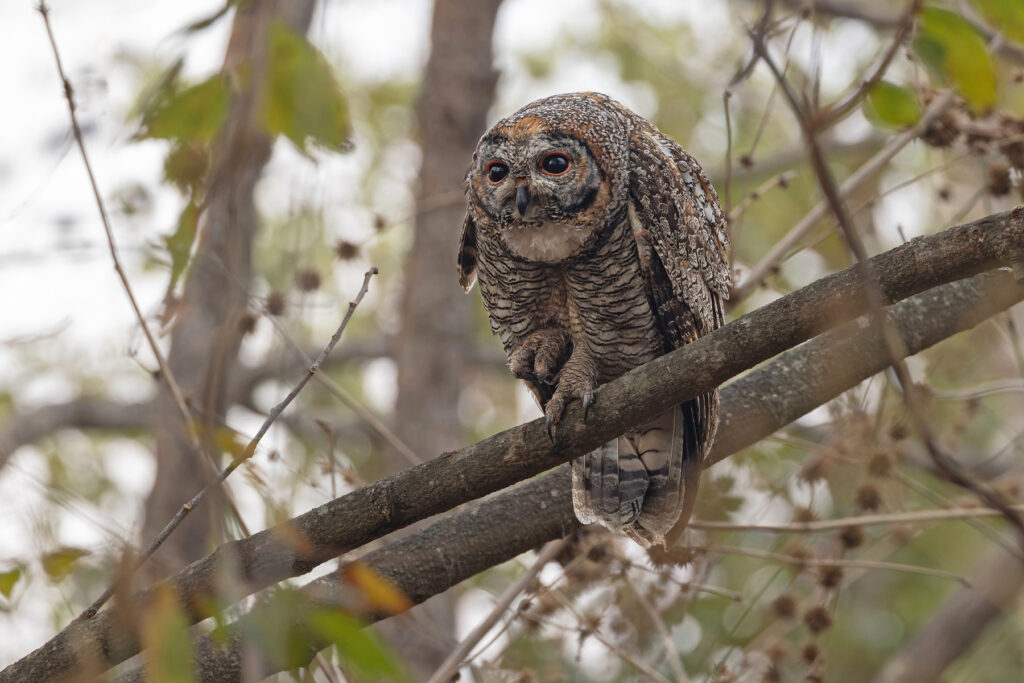
A feisty Mottled Wood Owl in Tadoba Andhari Tiger Reserve (image by Mike Watson)
The afternoon safari at Agarzari gate was a very relaxed affair, with our new team of guides and drivers instructed to stop for everything. We enjoyed some lovely views of waterbirds, including Grey-headed Swamphen, Black-winged Stilt, Pheasant-tailed Jacana, Wood Sandpiper, Asian Openbill, Black-headed Ibis, Glossy Ibis, Purple Heron, a Grey-headed Fish Eagle, mobbed by a crazy Jungle Crow, several Indian Rollers, White-throated Kingfishers and another couple of occupied Mottled Wood Owl nest sites. Although we did not see any tigers this afternoon it was a very pleasant ride and much appreciated by all after the previous afternoon’s rally stages.
We were back to Khutwanda gate again, now becoming familiar with many of its inhabitants we enjoyed another fun display by Indian Peafowl some nice views of Crested Honey Buzzard and Common Tailorbird, as well as a rather brief female Tiger on the move near Jamni meadows, which afforded a decent photo opportunity for one of our jeeps towards the end of the ride. Just when we thought it was all over, the jeep which had missed the Tiger shot happened upon a wild dog kill, or at least the aftermath of one, the pack of seven dogs ripping apart an unfortunate spotted deer in front of our eyes. Not for the faint-hearted but what action images in the dust and commotion! We returned to the very pleasant Agarzari gate in the afternoon where our new team had a tiger sighting already lined up for us. This was of the big male known as Y-mark, a well-known Casanova of this region of the park, having sired several litters of cubs. He was a truly magnificent beast but was asleep on his back, obscured among the bamboo but we decided to stick with him in the hope that he would do something before sunset. Lucky for us, after all the other jeeps had left he did eventually get up and walk down to the tiny stream by which he was sleeping and got in for an afternoon dip. What a magical experience this was with only our two jeeps present and him a mere 10 metres away in a wonderfully photogenic setting. Just before sunset he got out of the water and went off on patrol disappearing into the forest. That was the sighting we had been or waiting for, a proper grade A encounter.
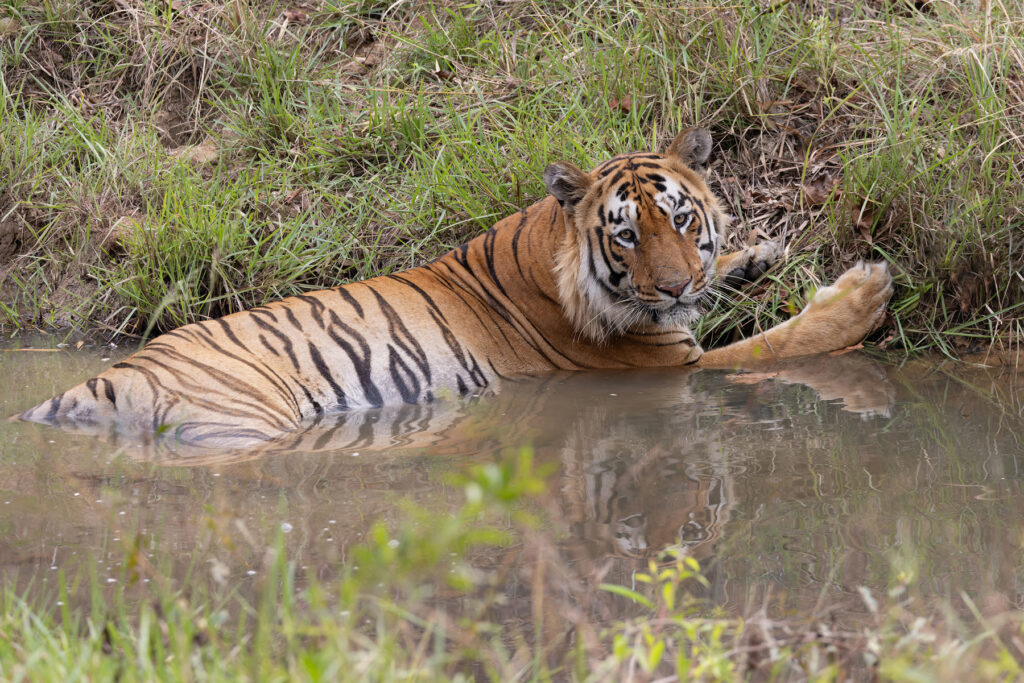
Lothario ‘Y-mark’ takes an afternoon dip in a quiet corner of Tadoba’s Agarzari Zone – FAB-U-LOUS! (image by Mike Watson)
A combination of the Dewada and Agarzari gates followed but this was typically an anti-climax after Y-mark’s performance, but we did manage some interesting birds in both places, as well as a herd of Gaur (or ‘Goo-arr’ Graham!), containing several males but mostly females with calves and nicely backlit on the track and sides. We also heard our first wailing by one of the males, a truly blood curdling sound. In the afternoon we had another sighting of Y-mark sleeping by a pool in the Agarzari zone, albeit obscured, however, he did not wake up before it was time to leave this time and we left him to his slumber. There was much happening by the waterhole, and we enjoyed excellent views of Common Hawk Cuckoo, the humble Spotted Dove, Black-naped Monarch, Orange-headed Thrush, Red-breasted Flycatcher and Green Imperial Pigeon during our wait.
Our sixth full day at Tadoba began back at Khutwanda gate where we followed fresh sloth bear tracks towards the central zone although unfortunately these veered away before the junction with the main central road. It was a cooler start today, although warming up later but less hot than previous days with a light cloud cover. This improved our encounter with a beautiful leopard, which crossed in front of the first Jeep and walked alongside the track for some knockout images. A timely reminder that stopping for more peacock photos during big cat time is not always a good idea.
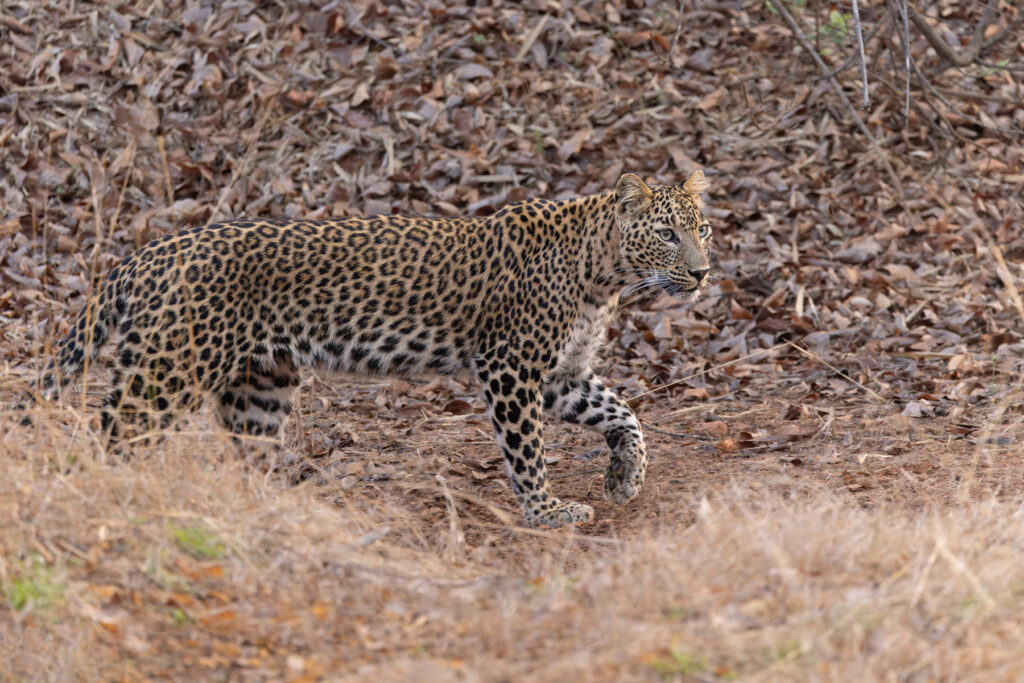
A truly gorgeous Leopard lit up our early morning at Tadoba, it was sadly a reminder for some not to stop for peacocks during big cat time (image by Mike Watson)
Only some of the second jeep saw the rear end of our leopard disappearing into the bush but they were quickly cheered up by another magnificent tiger sighting of a mother and her two year old Cubs at Jamni meadows. They crossed the jeep track and headed into the forest but not before one of the cubs squared up to a brave Gaur, complete with cattle egret on its back, what a sight that was!
Soon afterwards we encountered the huge male Tiger Mowgli at Pandarpauni, powering through some bamboo, but not photographable this time. To complete a hat-trick of tiger sightings this morning Choti Tara was around again, first spotted wandering along the bank of Pandarpauni No. #2 waterhole, before backing into the water and taking a dip, swimming towards us before she then got out of the water and started walking west bound for the ‘Traffic Jam’ waterhole, clever Little Star knew she would need to take a dip before the c2km walk in the hot sun!
Other interesting sightings this morning included a photogenic Nilgai with a nice forest background some langur monkeys and a Ruddy Mongoose, which looked back at us a couple of times before scuttling away into the undergrowth. Much of the afternoon was spent at Pandarpauni in the hope that Mowgli would wake up and do something but he remained almost completely obscured behind bamboo and did not wake up before it was time for us to leave at 6:00 PM. We encountered another leopard, our second of the day, in a quiet wooded valley just north of the central zone gate, first spotted in a watercourse as we sped by, and then sharp-eyed Yadav relocated it quietly looking at us not far away. What a great way to end another classic day in Tadoba!
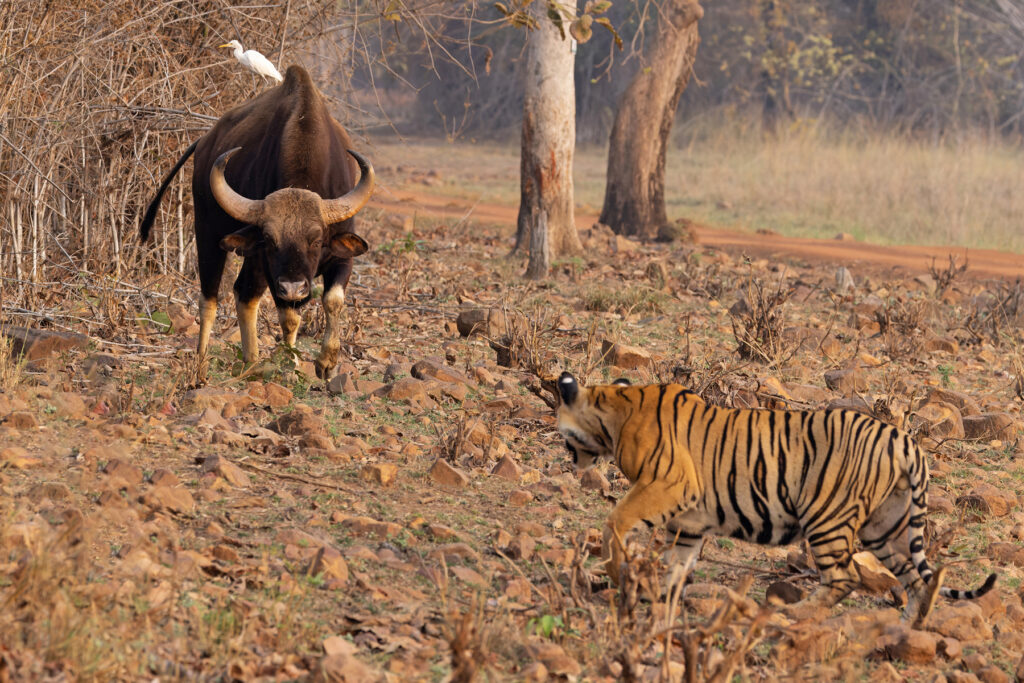
A brave Gaur, complete with Cattle Egret adornment in a stand-off with a Tiger at Tadoba Andhari Tiger Reserve (image by Mike Watson)
The next day also started at Khutawanda gate, where we quickly heard news of a male tiger calling, heard by the core area gateman. We doubled back and soon caught up with him as he headed towards our home gate, however, he veered away, seen only by David. Then followed a frustrating morning of wrong decisions following up tiger sightings along the main road and then then Jamni Meadows. Nothing seemed to work today in complete contrast to 3 April. It was just one of those mornings, despite our guys’ best efforts we always seemed to be in the wrong place at the wrong time. It happens!
The afternoon saw us visit a new gate, Neemdela. This can only be described as a work in progress. The ramshackle jeeps, one of which broke down, just about got us around our chosen circuit, the saving grace being the fact that this zone is absolutely rammed with tigers now. We saw three large cubs asleep on arrival, two of which we caught up later as they climbed the escarpment behind the small waterhole where they had been sleeping and we also finally set eyes on the biggest and baddest tiger in Tadoba, Chota Makta, son of Choti Tara, asleep in a forest stream. He was partly obscured by branches and twigs. Try as we might, we couldn’t really get an acceptable window shot of his face today. Neemdela also produced some wonderful Common Kingfisher images and a couple of point-blank Crested Serpent Eagles at eye level, which were very nice. A handful of photogenic Gaur followed as well as a distant Chowsingha for one of the jeeps at a remote waterhole. The rest of the afternoon was frustration for some but point-blank tiger views for others, although often with their faces covered by grass.
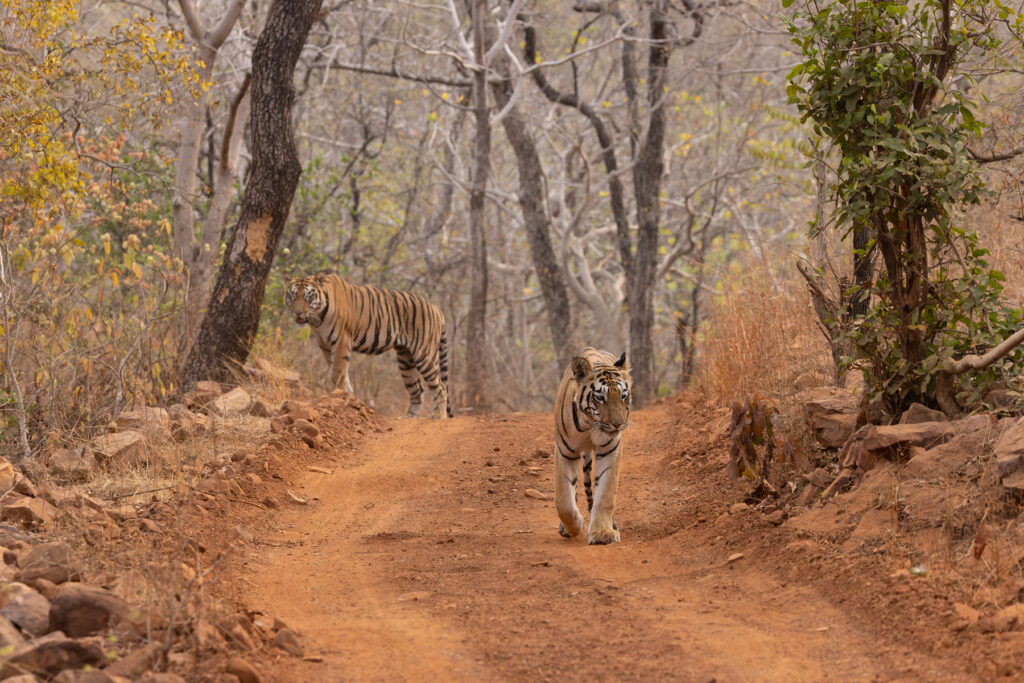
One of these two Tigers is a maneater, having killed two gatemen at Neemdela within the last month, now which one? (image by Mike Watson)
Day 8 saw us back at Khutwanda gate for one last time, so this time we decided to fill in some gaps today and ignored tiger news.
A nice ghost tree sunrise was followed by a lovely monkey photo session with some great mother and infant interaction, delightful stuff! A pair of Indian Stone-curlews was the only other worthwhile opportunity this morning among the regular forest birds. In the afternoon we returned to the distant named dealer gate and enjoyed another session of frustration and delight. This time the delight came in the form of seven tiger sightings – two clubs sleeping near the temple, a female in deep forest, and then Chota Makta again, sleeping deep under trees by the kingfisher spot, which he had walked to overnight.
Up on the plateau we had one of our best encounters with three 19 months old cubs by a water hole, interacting with langur monkeys and a suicidal wild boar, which survived a face-off with one of the tigers. With the sun setting jeep no.#1 decided to roll the dice on another tiger sighting, which transpired simply to be Chota Makta again, although we did manage some nice shots of his face through foliage. While we were wondering why we had abandoned the three cubs he woke and trundled through the forest a short distance, crossing the track between jeeps and scratching a tree, a very impressive sight indeed. However, this sighting was curtailed by an unwelcome swarm of honeybees, which we narrowly avoided. Our second Jeep was not so lucky, and the dithering driver did not take action quickly enough, resulting in a number of stings. A sad way to end what should have been a crowning moment of our wildlife encounters. Hopefully the memories of the awesome tiger views will last longer than those of the bee stings.
Our final safari morning was a spin around the Junona Beat of the Dewada zone. A wild tiger chase drew a blank, although we did manage some nice bird images while waiting for the non-sighting including flight shots of Asian Openbill, Lesser Adjutant, Oriental Darter and Red-naped Ibis. Our usual Jungle Owlet tree was again occupied by three cute little owlets and some managed images of Indian Golden Oriole.
Probably the best sighting of the entire tour took place today – a pair of honey Badgers crossed the main jeep track not far from the Dewada Gate for one of our jeeps, a rarely seen animal in Tadoba. For instance, it was our senior guide Lahu’s first sighting in Dewada Zone in 30 years and our other guide first Tadoba full stop.
Before too long it was time to say goodbye to this wonderful tiger reserve and make our way back to Nagpur via a super little lunch stop arranged by our Indian food enthusiasts. Thanks to our very enthusiastic group for making this trip such fun for most of the time. We will be back in incredible India next year!
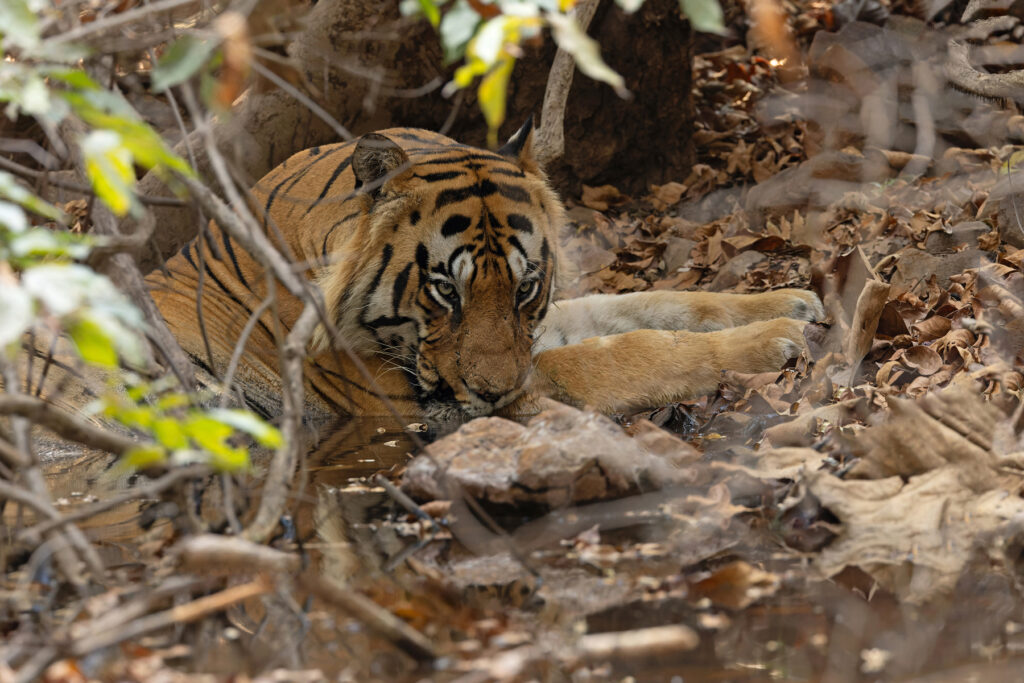
Chotka Matka, the biggest and baddest boss of Tadoba Andhari Tiger Reserve (image by Mike Watson)























































































